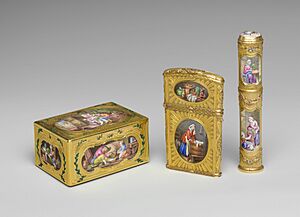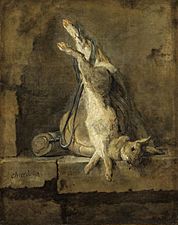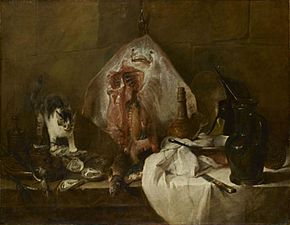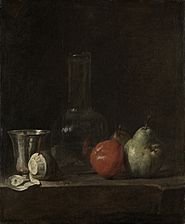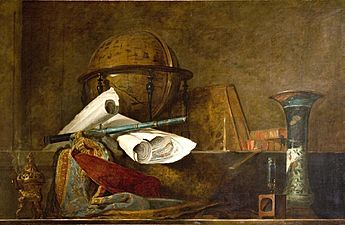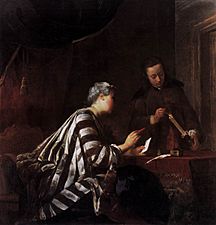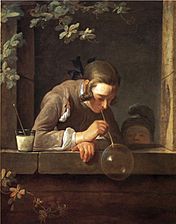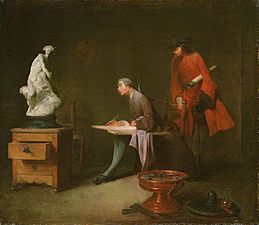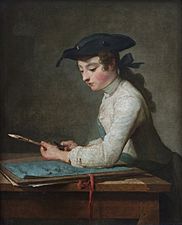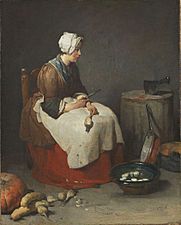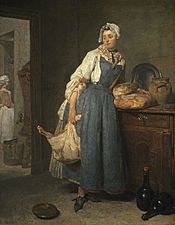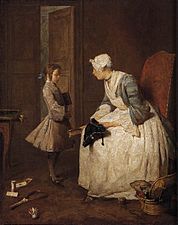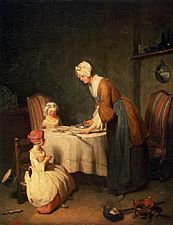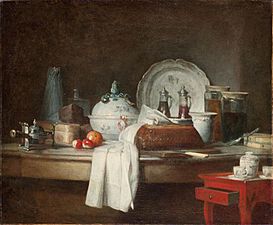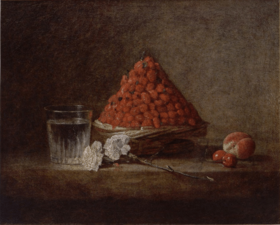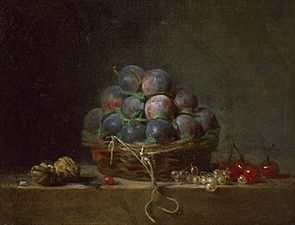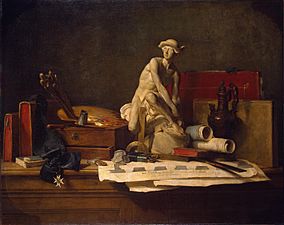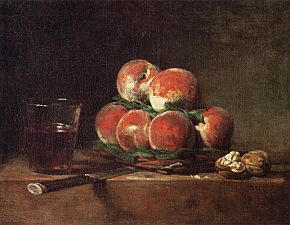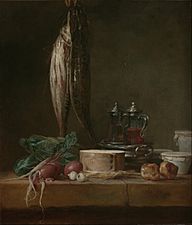Jean Siméon Chardin facts for kids
Quick facts for kids
Jean Siméon Chardin
|
|
|---|---|

Self-portrait, 1771, pastel, Louvre
|
|
| Born | 2 November 1699 Rue de Seine, Paris, France
|
| Died | 6 December 1779 (aged 80) Louvre, Paris, France
|
| Resting place | Saint-Germain l'Auxerrois |
| Nationality | French |
| Education | Pierre-Jacques Cazes, Noël-Nicolas Coypel, Académie de Saint-Luc |
| Known for | Painting: still life and genre |
|
Notable work
|
|
| Movement | Baroque, Rococo |
| Patron(s) | Louis XV |
Jean Siméon Chardin (November 2, 1699 – December 6, 1779) was a famous French painter from the 1700s. He is known as a master of still life paintings. These are pictures of everyday objects like fruit, dishes, or flowers. He also painted "genre" scenes, which show normal life. His paintings often feature kitchen helpers, children, and people doing things at home. Chardin's art is special because of its careful balance, soft light, and textured paint.
Life of Jean Chardin
Chardin was born in Paris. His father was a cabinetmaker, someone who makes fine furniture. Chardin rarely left Paris during his life. He lived on the Left Bank of the city until 1757. Then, King Louis XV gave him a special studio and home in the Louvre. The Louvre is now a famous museum.
Chardin planned to marry Marguerite Saintard in 1723, but they did not marry until 1731. He learned painting from two history painters, Pierre-Jacques Cazes and Noël-Nicolas Coypel. In 1724, he became a master at the Académie de Saint-Luc. This was an art school in Paris.
It was hard for new painters to get noticed by the Royal Academy. But Chardin first became known by showing a painting at a small art event. This event was held near the Pont Neuf, a famous bridge. Another painter, Jean-Baptiste van Loo, saw his work in 1720. Van Loo bought the painting and later helped the young Chardin.

In 1728, Chardin showed two paintings, The Ray and The Buffet. Because of these works, he was accepted into the Académie Royale de Peinture et de Sculpture. This was a very important art academy. He earned a living by painting different types of pictures. He also worked on restoring old paintings, like the ones at Fontainebleau in 1731.
In 1731, his son Jean-Pierre was born. His daughter, Marguerite-Agnès, was born in 1733. Sadly, his wife Marguerite died in 1735. His daughter Marguerite-Agnès also died within two years.
Starting in 1737, Chardin regularly showed his art at the Salon. The Salon was a big art exhibition in Paris. He was a very dedicated member of the Academy. He went to meetings for 50 years. He also held important roles like treasurer and secretary. In 1761, he helped set up the Salon exhibitions.

Chardin's art became popular through copies made by other artists. These copies were called engravings. They helped him earn money, like royalties today. In 1744, he married for the second time to Françoise-Marguerite Pouget. This marriage greatly improved his financial situation. They had a daughter, Angélique-Françoise, in 1745, but she died in 1746.
In 1752, King Louis XV gave Chardin a pension, which was like a regular payment. In 1756, Chardin started painting still life pictures again. In 1759, he showed nine paintings at the Salon. A famous writer named Denis Diderot saw his work. Diderot became a big fan and supporter of Chardin's art.
By 1761, Chardin was very busy with his duties at the Salon. He arranged exhibitions and managed money. This meant he painted less new works. He often showed copies of his older paintings. In 1763, he received an extra pension for his work at the Academy. By 1770, Chardin was known as the 'Premier peintre du roi' (First painter to the King). His pension was the highest in the academy.
In the 1770s, Chardin's eyesight started to get weaker. He began to paint with pastels. Pastels are like colored chalks. He made portraits of his wife and himself using pastels. These pastel works are now very valuable. His last known oil painting was from 1776. He showed several pastel studies at his final Salon exhibition in 1779. Chardin became very ill and died in Paris on December 6, 1779, at the age of 80.
Chardin's Artworks

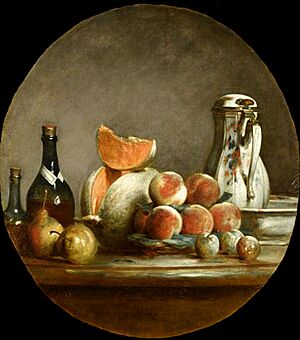
Chardin painted slowly and created just over 200 pictures in his whole life. This is about four paintings a year.
His art was quite different from the Rococo painting style popular in France during the 1700s. Rococo art was often fancy and decorative. At that time, history paintings were considered the most important type of art. But Chardin chose to paint simpler subjects. He liked to paint still lifes that looked real and had beautiful textures. He also painted quiet scenes of homes and everyday activities.
Chardin's paintings of common household items, like a smoker's box, were simple but beautiful. He also showed children's innocence in a very real way, like in his painting Boy with a Top. People liked his art then, and it is still popular today.
Chardin mostly taught himself how to paint. He was inspired by the realistic art of 17th-century Dutch and Flemish painters. Even though his art showed ordinary people, he had support from rich French families, including King Louis XV. At first, he was known for paintings of animals and fruit. By the 1730s, he started adding kitchen items to his works, like in The Copper Cistern.
Soon, people started appearing in his scenes too. This happened after another painter challenged him to try painting people. Woman Sealing a Letter (around 1733) might have been his first try. After that, he painted children saying grace, like in Le Bénédicité, and kitchen maids thinking quietly. These simple scenes show everyday life. They also give us a look into French society that was not usually painted. Chardin's pictures are known for their good structure and harmony. Chardin once said, "Who said one paints with colors? One uses colors, but one paints with feeling."
Chardin loved to paint children playing. He painted a teenager building a house of cards at least four times. The one at Waddesdon Manor is the most detailed. These scenes were inspired by older Dutch paintings that reminded people about how short life is. But Chardin's paintings also show the joy of childhood moments.
Chardin often made copies of his own paintings, especially his genre scenes. Many of his paintings exist in several versions that look almost the same. After The Governess (1739), Chardin started painting scenes of middle-class life. His about 200 paintings are now in many major museums, including the Louvre.
Chardin's Influence on Art
Chardin had a big influence on modern art. Many famous artists were inspired by him. For example, Édouard Manet's Boy Blowing Bubbles and the still lifes of Paul Cézanne were influenced by Chardin. He was one of Henri Matisse's favorite painters. When Matisse was an art student, he copied four of Chardin's paintings at the Louvre.
The still life paintings of Chaïm Soutine, Georges Braque, and later, Giorgio Morandi also looked to Chardin for ideas. In 1999, Lucian Freud painted and etched several copies of Chardin's The Young Schoolmistress.
The writer Marcel Proust wrote about Chardin in his book In Search of Lost Time. He described a sad young man who found comfort in imagining grand palaces from famous paintings. Proust then tells the young man to look at Chardin's paintings in the Louvre. There, he would see the beauty in simple still life scenes at home and in everyday things, like peeling vegetables.
Gallery
-
Dead Rabbit and Hunting Gear (around 1727), at the Louvre
-
The Ray (1727), at the Louvre
-
Soap Bubbles (around 1733-1734), at the National Gallery of Art
-
The Draftsman (1737), at the Louvre
-
The Return from the Market (1738–39), at the Louvre
-
The Governess (1739), at the National Gallery of Canada
-
Portrait of Auguste Gabriel Godefroy (1741), at the São Paulo Museum of Art
-
Saying Grace (1744), at the Hermitage Museum
-
The Attentive Nurse (1747), at the National Gallery of Art
-
The Good Education (around 1753), at the Museum of Fine Arts, Houston
-
La Brioche (1763), at the Louvre
-
Basket of Plums (1765), at the Chrysler Museum of Art
-
Still Life with Attributes of the Arts (1766), at the Hermitage Museum
-
Basket of Peaches, with Walnuts, Knife and Glass of Wine (1768), at the Louvre
See also
 In Spanish: Jean Siméon Chardin para niños
In Spanish: Jean Siméon Chardin para niños
- The Attributes of Civilian and Military Music
- Soap Bubbles (painting)


